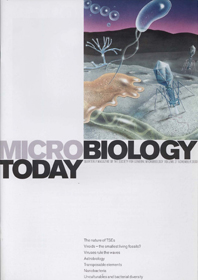Microbiology – the twilight zones
01 November 2000 publication
The lead articles of the November 2000 issue of Microbiology Today are on the nature of TSEs; viroids – the smallest living fossils?; viruses rule the waves; astrobiology; transposable elements; nanobacteria; and unculturables and bacterial diversity.
The twilight zones of microbiology (p. 152)
John Postgate look at why the 'twilight zones of microbiology' should not be ignored.
The nature of TSEs (p. 164)
Scientists are unsure of the identity of the causative infectious agent of TSEs, but the properties are unlike those of conventional pathogens. Christ Bostock explores the nature of TSEs.
Viroids and other sub-viral pathogens of plants: the smallest living fossils? (p. 168)
Viroids and satellite RNAs are the smallest and simplest replicating molecules known. Possibly 'living fossils', Nicola Spence and Dez Barbara discuss how they are the cause of a wide variety of infectious diseases in plants.
Viruses rule the waves – the smallest and most abundant members of marine ecosystems (p. 171)
Some 10 years ago a series of letters was published in Nature showing that bacteriophages were both abundant and active in natural waters. Gunnar Bratbak and Mikal Heldal explain how these reports boosted research on the ecological significance of viruses and the field is now well established as an integral part of aquatic microbial ecology.
In search of a second evolutionary experiment (p. 174)
The UK Astrobiology Forum defines astrobiology as the 'formation, evolution and adaptation of life in a planetary and stellar context'. Don Cowan and Monica Grady describe current thinking on extra-terrestrial life.
Mobile genes (p. 178)
Mobile genes and transposons are found widely in nature. Nicholas West and Christoph Tang look at prokaryotic transposons and their potential exploitation by microbiologists.
Nanobacteria: gold mine or minefield of intellectual enquiry (p. 182)
Nanobacteria are very small cellular forms which seem to be closely linked with the formation of geological strata. Do they really exist? If so, their impact on our understanding of living systems is potentially huge, writes Allan Hamilton.
Bacterial diversity and 'unculturables' (p. 186)
Many previously unknown groups of bacteria have been identified by 16S rRNA gene sequencing. John Fry speculates how unculturable many of these microbes really are.
Going Public (p. 194)
Reg England reports on the Microbiology Summer School for 11-15 year old pupils event that was held at the University of Central Lancashire.
Gradline (p. 196)
Tracey Duncombe describes the final round of this year's Promega Prize competition. Eight enthusiastic young members each gave a 10-minute talk followed by 5 minutes of questions. Afterwards, Tracey met up with the contestants to find out more about the importance of their research and why they had entered the competition.
Comment – Archaea are really mesophiles with attitude! (p. 220)
Dave Roberts illuminates a view of the Archaea in toto.

